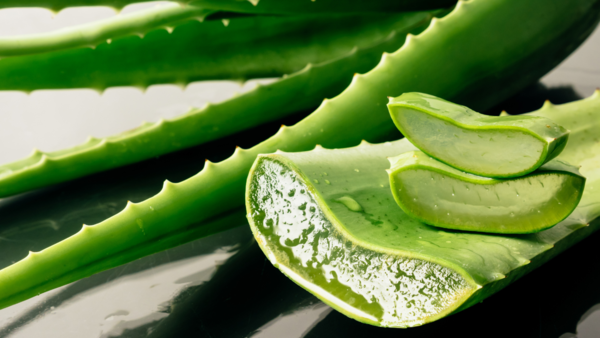The science behind aloe vera
Aloe vera, a succulent plant known for its gel-filled leaves, contains a variety of compounds beneficial to the skin and hair.These include vitamins (such as vitamins A, C, and E), minerals (such as zinc and magnesium), amino acids, and enzymes. These components contribute to aloe vera’s reputation as a soothing, moisturizing, and anti-inflammatory agent.
1. Nutrient profile: Aloe vera gel is rich in vitamins and minerals that are vital for healthy hair growth. Vitamin A promotes cell turnover, while Vitamin C and E are antioxidants that protect hair follicles from oxidative stress. Zinc supports hair health by contributing to the repair and function of hair tissues.
2. Enzymatic action: Aloe vera contains proteolytic enzymes that help remove dead skin cells from the scalp, which can contribute to follicle blockages and impaired hair growth. This exfoliating action could potentially create a healthier environment for hair growth.
3. Anti-inflammatory properties: The anti-inflammatory properties of aloe vera can help soothe an irritated scalp and reduce dandruff, a condition that can contribute to hair loss. By reducing inflammation, aloe vera may help maintain a healthier scalp environment which is conducive to hair growth.
5 Essential oils everyone must have for pain relief and overall health
Evidence on aloe vera and hair growth
While the theoretical benefits of aloe vera are compelling, what does scientific research say about its efficacy in promoting hair regrowth?
1. Clinical studies: There is limited but promising research into the role of aloe vera in hair growth. A study published in the Journal of Dermatology in 2009 investigated the use of aloe vera in treating androgenetic alopecia (a common form of hair loss). The study found that aloe vera had a positive effect on hair regrowth in participants, primarily due to its ability to improve scalp health and reduce inflammation.
2. Case reports and anecdotal evidence: Various anecdotal reports and case studies have highlighted the positive impact of aloe vera on hair health. Many people have reported experiencing less hair shedding and improved hair growth after using aloe vera gel regularly. However, these reports lack the rigor of controlled scientific studies and should be interpreted with caution.
3. Comparison with other treatments: While aloe vera is a natural remedy, its efficacy should be compared with other established treatments for hair loss, such as minoxidil and finasteride. Aloe vera may be a helpful adjunct to conventional treatments but should not be relied upon as a sole solution for significant hair loss.

Aloe Vera juice is considered to be a powerhouse of nutrients, which has vitamins, minerals, and antioxidants. This juice offers numerous health benefits, making it an excellent supplement to your daily routine. Regular consumption of this rejuvenating juice can help you get multiple advantages like helping in weight loss by boosting metabolism and promoting fat burn. Additionally, it enhances digestion, providing relief from common issues like bloating and indigestion. Its immune-boosting properties also strengthen the body’s defenses by preventing infections and diseases.
Application and usage
If you’re considering using fresh aloe vera gel to enhance hair growth, proper application is key. Here’s how to use it effectively:
1. Extracting fresh gel: To use fresh aloe vera, cut a leaf from the plant, slice it open, and scoop out the clear gel. Ensure the gel is clean and free from any green or yellowish parts, as these can cause irritation.
2. Scalp application: Massage the fresh aloe vera gel directly onto your scalp. Focus on areas where hair thinning is evident. Leave it on for about 30 minutes to an hour before rinsing it out with a mild shampoo.
3. Frequency: For optimal results, apply aloe vera gel 2-3 times a week. Consistency is important, but it’s also crucial to monitor how your scalp and hair respond to the treatment.
Potential side effects
While aloe vera is generally safe for most people, it’s important to be aware of potential side effects:
1. Allergic reactions: Some individuals may experience allergic reactions to aloe vera, such as redness, itching, or a rash. It’s advisable to perform a patch test before applying it extensively to your scalp.
2. Dryness or irritation: In rare cases, aloe vera can cause scalp dryness or irritation. If you notice these symptoms, discontinue use and consult a dermatologist.
3. Interaction with other treatments: If you are using other topical treatments for hair loss, ensure there are no adverse interactions between aloe vera and those products. It’s best to consult with a healthcare provider if you’re uncertain.
The use of fresh aloe vera gel as a remedy for hair regrowth presents a blend of science and tradition. While there is some evidence to support its benefits in improving scalp health and potentially aiding hair growth, it should not be viewed as a miracle cure. Aloe vera can be a useful addition to a comprehensive hair care routine, particularly when combined with other evidence-based treatments. Share your experience with aloe vera in the comment section below.

Rachel Carter is a health and wellness expert dedicated to helping readers lead healthier lives. With a background in nutrition, she offers evidence-based advice on fitness, nutrition, and mental well-being.







